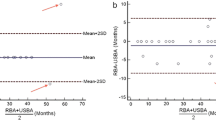Abstract
Background
Radiographic bone age determination is part of the routine evaluation of suspected growth disorders. Simplicity and low cost are its major advantages, but although the effective dose of ionizing radiation is low, it should be taken into consideration given its cumulative effect.
Objectives
To assess the chronological ultrasonographic emergence of the ossification centers of the hand and wrist.
Materials and methods
Cross-sectional study of healthy patients ages 1 to 24 months (n = 498) from Buenos Aires, Argentina. All patients underwent ultrasonographic evaluation of the left hand and wrist to identify the different bone nuclei; a subgroup of infants had their nuclei measured (n = 228).
Results
Girls showed an earlier emergence of the evaluated nuclei and a trend to a greater size than age-matched boys. Size-for-age relation showed linear increase. Carpal bones (capitate and hamate) were the first to appear, as early as from the first 3 months of life, an age gap not thoroughly present on the radiographic atlas developed by Greulich and Pyle. The distal epiphysis of the radius and the second metacarpophalangeal joint (index finger) followed in order of emergence. The proximal epiphysis of the first metacarpal bone (thumb) was the last to emerge and was infrequently found on boys at age 24 months. Overall, these findings are in accordance with the radiographic atlas. An ultrasonography atlas of the left hand and wrist was outlined for girls and boys.
Conclusion
Conventional ultrasonography allows proper identification of the ossification centers of the hand and wrist and may become an innocuous follow-up tool for patients with growth disorders.




Similar content being viewed by others
References
Growth Hormone Research Society (2000) Consensus guidelines for the diagnosis and treatment of growth hormone (GH) deficiency in childhood and adolescence: summary statement of the GH research society. J Clin Endocrinol Metab 85:3990–3993
Todd W (1937) Atlas of skeletal maturation --hand. The C.V. Mosby Company, St. Louis
Greulich W, Pyle S (1959) Radiographic atlas of skeletal development of the hand and wrist, 2nd edn. Stanford University Press, California
Castriota-Scanderbeg A, Sacco MC, Emberti-Gialloreti L et al (1998) Skeletal age assessment in children and young adults: comparison between a newly developed sonographic method and conventional methods. Skeletal Radiol 27:271–277
Tanner J, Oshman D, Bahhage F et al (1997) Tanner-Whitehouse bone age reference values for North American children. J Pediatr 131:34–40
Tanner J, Healy M, Goldstein H et al (2001) Assessment of skeletal maturation and prediction of adult weight (TW3 method), 3rd edn. WB Saunders, London
Gentili P, Trasimeni A, Giorlandino C (1984) Fetal ossification centers as predictors of gestational age in normal and abnormal pregnancies. J Ultrasound Med 3:193–197
Wagner UA, Diedrich V, Schmitt O (1995) Determination of skeletal maturity by ultrasound: a preliminary report. Skeletal Radiol 24:417–420
Castriota-Scanderbeg A, Micheli V (1995) Ultrasound of femoral head cartilage: a new method of assessing bone age. Skeletal Radiol 24:197–200
Bilgili Y, Hizel S, Kara SA et al (2003) Accuracy of skeletal age assessment in children from birth to 6 years of age with the ultrasonographic version of the greulich-pyle atlas. J Ultrasound Med 22:683–690
Mentzel H-J, Vilser C, Eulenstein M et al (2005) Assessment of skeletal age at the wrist in children with a new ultrasound device. Pediatr Radiol 35:429–433
Khan KM, Miller BS, Hoggard E et al (2009) Application of ultrasound for bone age estimation in clinical practice. J Pediatr 154:243–247
Lejarraga H, Guimarey L, Orazi V (1997) Skeletal maturity of the hand and wrist of healthy Argentinian children aged 4–12 years, assessed by the TWII method. Ann Hum Biol 24:257–261
Mentzel HJ, Vogt S, Vilser C et al (2005) Assessment of skeletal age using a new ultrasound method. Röfo 177:1699–1705
Carpenter CT, Lester EL (1993) Skeletal age determination in young children: analysis of three regions of the hand/wrist film. J Pediatr Orthop 13:76–79
Garn SM, Rohmann CG (1960) Variability in the order of ossification of the bony centers of the hand and wrist. Am J Phys Anthropol 18:219–230
Garn SM, Rohmann CG (1962) Parent–child similarities in hand-wrist ossification. Am J Dis Child 103:603–607
Ontell FK, Ivanovic M, Ablin DS et al (1996) Bone age in children of diverse ethnicity. AJR Am J Roentgenol 167:1395–1398
Conflicts of interest
None
Author information
Authors and Affiliations
Corresponding author
Rights and permissions
About this article
Cite this article
Daneff, M., Casalis, C., Bruno, C.H. et al. Bone age assessment with conventional ultrasonography in healthy infants from 1 to 24 months of age. Pediatr Radiol 45, 1007–1015 (2015). https://doi.org/10.1007/s00247-014-3253-0
Received:
Revised:
Accepted:
Published:
Issue Date:
DOI: https://doi.org/10.1007/s00247-014-3253-0




